They remember Boris Karloff as "The Monster", but not the man who made him. Except for that one line of dialogue. His motion picture career lasted for only 18 feature films and by the age of 37 he was dead. This is the tragic history of "Colin Clive: Henry, Not Victor Frankenstein". 
Colin Glenn Clive-Greig was born on January 20, 1900 in Saint-Malo, Brittany, France. His father was British Colonel Colin Philip Greig and his mother was Caroline Margaret Lugard Clive. As a young man he wanted to become a professional soldier like his father. He entered the Jesuit,"Stonyhurst College", a co-educational Catholic school located on the "Stonyhurst Estate" in Lancashire, England. 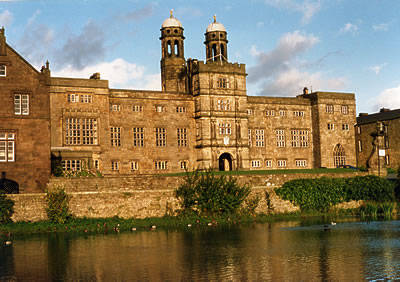
Colin followed "Stonyhurst" by entering the "Royal Military Academy, Sandhurst" located in Camberley, England.
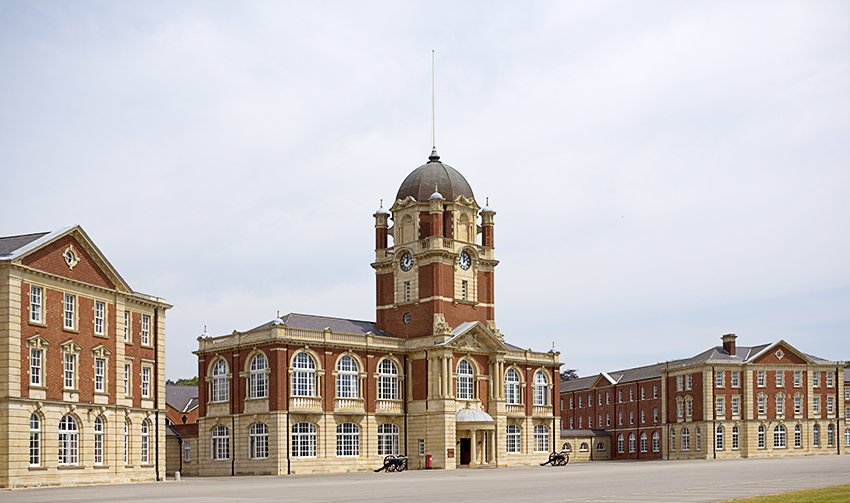
However, his dream of a military career was cut short by an accident to one of his knees that disqualified him for military service.
I should point out that Colin Glenn Clive-Grieg's family had a strong history of military service to the British Empire. One of his ancestors was Major-General Robert Clive, 1st Baron Clive. Who would become known to British history as "Clive of India", 1744, and is credited, with Warren Hastings, of laying the foundation for the British Empire in India that lasted into 1947.
Above "Clive of India" around 1764.
Acting On the British Stage
Around the age of 20, after having to leave "Samdhurst", the young man turned to his second passion acting and entered the British Theater. In 1922 Colin Clive married Evelyn Taylor, but she passed away in 1929. I could not locate any information on her.
Of his early stage career I could locate little, but his work had to have been solid. Because on May 3, 1928, at the "Theatre Royal", on Drury Lane, in the West End of London, the first British production of American composers Jerome Kern and Oscar Hammerstein's musical "Show Boat" opened.

The cast included the great African-American singer Paul Roebson as "Joe", the future Sir Cedric Hardwicke as "Captain Andy", Edith Day as "Magnolia" and Alberta Hunter as "Queenie". Portraying "Steve Baker", the husband of the half-white "Julie Laverne", I could not locate who portrayed her, was Colin Clive.
On December 8, 1928 a dramatic play, "Journey's End", set during World War One, opened at the "The Apollo" in London's West End. In the role of "Captain Stanhope" was an unknown actor named Laurence Olivier. Also in the cast were George Zucco as "Lieutenant Osborne" and Maurice Evans as "2nd Lieutenant Trotter". Most of my readers would know Evans as either "Samantha Stevens" father on televisions original "Bewitched", or as "Dr. Zaius" in the original "Planet of the Apes" movie series.
On January 21, 1929 the original cast, except Olivier, moved "Journey's End" to the West End "Prince of Wales" Theater. Where the replacement for Olivier was Colin Clive. The play had only one director since its conception, the unknown James Whale.

Above Colin Clive as "Captain Stanhope" in the original British stage production.
Also in 1929 Colin Clive married actress Jeanne de Casalis. She was born in Basutland on the border of South Africa. 
During their marriage the two would be estranged, off and on, for several years. One reason was he was working in the United States and she was acting in the United Kingdom. Two other reasons could have been Clive's reported bisexuality and his excessive drinking.
James Whale brought the cast of "Journey's End" to the United States, but without Colin Clive. He was replaced by another British actor Colin Keith-Johnston. Who, besides British stage work, had been seen in small roles in two British motion pictures. However, Clive decided to come to the States on his own and met with Whale in New York. This was fortuitous as Whale was about to make a motion picture version of the play and, it has been stated, wanted "A Real Alcoholic" in the role of "Alcoholic Stanhope". Obviously James Whale was aware of Colin Clive's drinking problem.
The Motion Pictures
JOURNEY'S END released April 9, 1930
The motion picture was a joint production of "Tiffany Pictures" in the United States and "Gainsborough Pictures" in the United Kingdom.
The film was released by "Tiffany Pictures" in the United States and "Woolf and Freedman Film Service" in the United Kingdom.
The Three Leads:
Colin Clive portrayed "Captain Denis Stanhope".
Ian Maclaren portrayed "Lieutenant Osborne". In 1923 the actor began his film career in the United Kingdom and moved to the United States. Except for this motion picture and Cecil B. DeMille's 1934 "Cleopatra". That starred Claudette Colbert, his roles became smaller and smaller. An example is playing "Sir Charles Baskerville" in the Basil Rathbone and Nigel Bruce 1939 "The Hound of the Baskervilles".
David Manners portrayed "2nd Lieutenant Raleigh". This was David Manners second on-screen appearance and there would be another six motion pictures, before he portrayed "Jonathan Harker" in director Todd Browning's 1931 "Dracula". Which would be followed by 13 forgotten motion pictures until he was "Frank Whemple" in 1932's "The Mummy".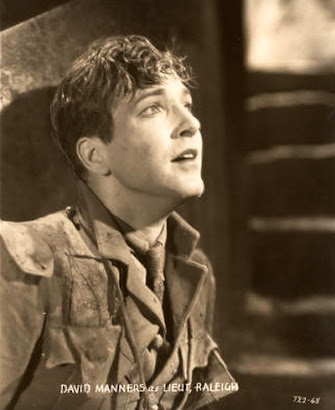
The Plot:
It is the eve of a battle in 1918 on the Western Front. A new officer, "2nd Lt. Raleigh", arrives in "Captain Stanhope's" company. The two knew each other at school and the young "Raleigh" hero-worshiped "Stanhope". Who was in love with his sister at the time. However, he comes to see "Stanhope" not as the man he worshiped, but as a man tired of war. Who has been driven to drink to survive day to day.
On December 5, 1930, at the "Longacre Theatre", on Broadway. Colin Clive would star in a play entitled "Overture". Its short run lasted into January and was in two acts set in a German town in 1920.
During 1930 family owned "Universal Studios" had lost $2,200,000 1930 dollars. Which equates to $34,133,065 at the time of this writing. However, the financial situation changed for the studio within 48 hours of the opening of Todd Browning's "Dracula", at the Roxy Theater, in New York City. That one site had sold 50,000 tickets.
Carl Laemmle, Jr., "Senior" had founded and technically owned the studio, realized the power of "Horror Movies". The young Laemmle immediately acquired the rights to a play, "Frankenstein", by authoress Peggy Webling. For some reason he did not just use the direct novel by Mary Wollstonecraft Shelley that was in public domain.
Bela Lugosi as a "Contract Player" was assigned to appear in the feature. Lugois wanted the role of the creature's creator, but was told he would be the monster. Below is one of the few remaining photos of Lugosi's make-up tests for the monster. Florey wanted the monster to be nothing more than an emotionless killing machine.
After a few unworkable screen tests. Lugosi left the project stating, according to legend:
I was a star in my country and I will not be a scarecrow over here!
As for Robert Florey, he was fired. Possibly because James Whale, who had delivered for Universal the successful "Waterloo Bridge", wanted the project.
Most of my readers are unfamiliar with "Waterloo Bridge", or even the 1936 classic version of Edna Ferber's "Show Boat" directed by Whale. My article, "JAMES WHALE: Jean Harlow to Louis Hayward", that covers these two features. May be found by those interested at:
http://www.bewaretheblog.com/2020/07/james-whale-jean-harlow-to-louis-hayward.html
FRANKENSTEIN released November 21, 1931
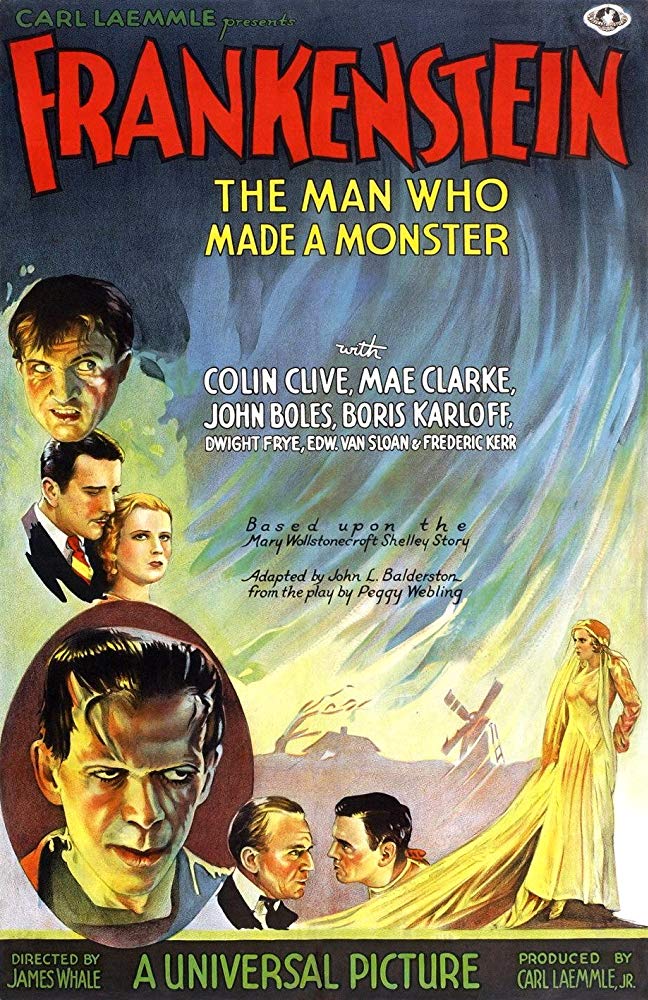
To begin with, as stated on the above poster, the correct title of the motion picture is:
FRANKENSTEIN THE MAN WHO MADE A MONSTER
Once the decision was made, by Carl Laemmle, Jr,. to fire Robert Florey and let Bela Lugosi go as he wished. "Junior", as he was called by even the studio janitors, did give the project to James Whale to direct.
The screenplay was adapted by John L. Balerston from the play by Peggy Webling. Balderston had already worked on the adaption of the play "Dracula" by Hamilton Deane. That had starred Lugosi on the Broadway Stage and would, later, write the screenplay for 1932's "The Mummy". Which was based upon a story, copyrighted to Hammer's regrets, by Nina Wilcox Putnam.
The actual screenplay was co-written by three others:
Garret Fort, 1931's "Dracula", and John Ford's 1934 "The Lost Patrol" starring Victor McLagen and Boris Karloff.
Francis Edward Faragoh, Meryvn Leroy's original 1931 "Little Caesar" starring Edward G. Robinson and Douglas Fairbanks, Jr. and the Lionel Barrymore and Helen Mack 1935 "The Return of Peter Grimm".
Richard Schayer had been writing screenplays since 1916. Among his work are 1932's "The Mummy", Todd Browning's 1936 "The Devil Doll" starring Lionel Barrymore and Maureen O' Sullivan. Who had been playing "Jane" opposite Johnny Weissmuller in MGM's "Tarzan of the Apes" series.
Receiving no on-screen credit, as contributor, was Robert Florey and also John Russell.
The Main Cast:
Colin Clive portrayed "Henry Frankenstein". Universal left Peggy Webling's name change from "Victor" to "Henry" in place. Trivia: if Boris Karloff was not wearing those very visible lifts as the monster. Clive was actually taller than Karloff and we might have seen a small monster than his maker.

Mae Clarke portrayed "Elizabeth". Although Clarke starred in James Whale's 1931 production of "Waterloo Bridge" and portrayed Tristram Coffin's leading lady in Republic Pictures 1949 "King of the Rocket Man" serial. That introduced the studios flying suit.
For motion picture trivia buffs. Mae Clarke is best remembered for portraying the non-on-screen credited role of "Kitty" in James Cagney's 1931 "Public Enemy". She was the girl Cagney pushes the grapefruit into her face in the breakfast table scene.
John Boles portrayed "Victor Mortiz". Boles was both a leading man and supporting actor for his 28 year career. He appeared as "Young Matt" in the 1928 silent picture "Shepherd of the Hills". In 1940 John Wayne portrayed "Matt" in the sound version. Boles co-starred with Bebe Daniels in the 1929 musical "Rio Rita", in 1932 he co-starred with Irene Dunne in "Back Street" based upon the bestselling Fannie Hurst novel. In 1935 John Boles co-starred with Shirley Temple in "Curly Top" and latter that year the two appeared in "The Littlest Rebel".
Above John Boles and Mae Clarke.
Boris Karloff portrayed "The Frankenstein Monster". Note in the opening credits his name is not shown. The billing under "The Players" reads:
The Monster---------?Peggy Webling's play was the first time both the creator and the monster are referred to as "Frankenstein" and the film's screenplay kept that point.
Karloff had been appearing on screen since 1919 in walk-on's and small non-credited roles. He had moved to fourth billing in director Howard Hawks 1930 "The Criminal Code" and was getting roles as criminals after that film until this one. In 1932 he portrayed rival gang leader "Tom Gaffney" in director Howard Hawks' original "Scarface" starring Paul Muni and Ann Dvorak, but it was the Horror movies people wanted to see him in.
Edward Van Sloan portrayed "Doctor Waldman". Van Sloan's first picture was in 1916, but the legitimate stage actor's second motion picture wasn't until he appeared as "Professor Van Helsing" in 1931's "Dracula". Van Sloan would repeat that role in 1936's "Dracula's Daughter". He would also be seen in 1932's "The Mummy" as "Dr. Mueller".

The lesbian "Dracula's Daughter" is part of a group of vampire movies that do not necessarily follow the Bram Stoker established mode. I look a them in "Not the Same Old VAMPIRE Movies, or Get Your Dentures Away from My Jugular Vein" at:
http://www.bewaretheblog.com/2017/10/not-same-old-vampire-movies-or-get-your.html
The Most Interesting Supporting Actor
Dwight Frye was "Fritz". This is a character not from Mary Shelley's "Frankenstein, or the Modern Prometheus", but from Peggy Weblings' play adapted for the screenplay by John L. Balerston. Frye had been seen as "Renfield" in the 1931 "Dracula", but also was "Wilmer Cook" in the 1931 original "The Maltese Falcon". My article "DWIGHT FRYE: Overlooked Horror Icon" can be read at:
http://www.bewaretheblog.com/2019/07/dwight-frye-overlooked-horror-icon.html

James Whale and Carl Laemmle, Jr., even though this film was released three years prior to the "Motion Picture Code" going into effect, came up with a plan to keep the censors mostly off the picture.
Before the story actually begins. Edward Sloane comes out of a closed curtain and addresses the audience giving them a warning about what they're about to see.
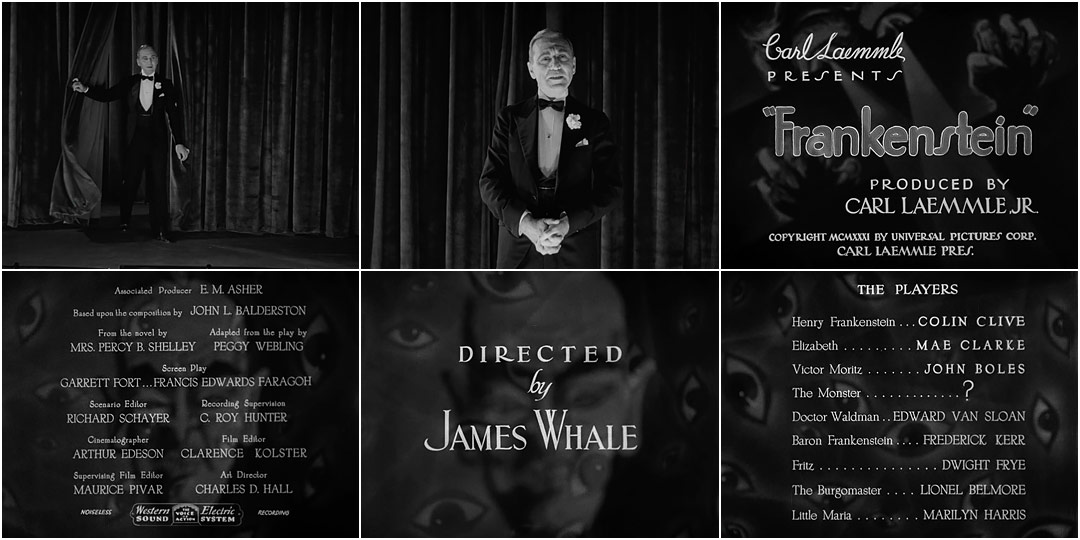
How do you do? Mr. Carl Laemmle feels it would be a little unkind to present this picture without just a word of friendly warning: We are about to unfold the story of Frankenstein, a man of science who sought to create a man after his own image without reckoning upon God. It is one of the strangest tales ever told. It deals with the two great mysteries of creation; life and death. I think it will thrill you. It may shock you. It might even horrify you. So, if any of you feel that you do not care to subject your nerves to such a strain, now's your chance to uh, well,––we warned you.
The Plot:
"Henry Frankenstein" and his assistant "Fritz" rob bodies from graves and scaffoldings and he assembles them into a new body with plans of using electricity to bring it to life.

"Elizabeth", his bride to be, goes to "Victor Mortiz" and "Doctor Waldman" with her concerns about "Henry's" health. The three go to the tower that contains "Henry's" laboratory and witness the "birth" of his creation.


The assembled body is raised to the top of the tower and exposed to lightening during a storm. After the body is lowered back down into the laboratory comes that famous line Colin Clive is remembered for---



What "Henry" doesn't know is that "Fritz" had dropped the brain he wanted to use and replaced it with an abnormal brain and "Henry Frankenstein" starts to feel the pressure of his deed. The creature is tormented by "Fritz" and after killing him, escapes and kills a little girl.

The monster enters "Elizabeth's" bedroom, but does not kill her.

"Henry" organizes the village people and they go in search of the monster. The climax comes as "Henry's" creation confronts him in a windmill and that the villagers set on fire. "Henry" is tossed off the windmill and the creature dies.



Colin Clive returned to the United Kingdom possibly to be with his wife and started working in feature films there for a short period of time.
He made the British feature "The Stronger Sex", that would be released on February 26, 1931, in London. Which of course was before "Frankenstein". The movie is important, as at 6th-billing is an actress Colin Clive would come work with again. She was his old stage acting partner, Elsa Lanchester.

Above the only known photo from "The Stronger Sex" is of Colin Clive.
LILY CHRISTINE released May 20, 1932
This was Colin Clive's second feature after his return to the U.K. The picture was shot at "Elstree Studio" by "Paramount British Pictures" a division of the American film company. The movie was described as a romantic drama.

Above the film's star Corinne Griffith as "Lilly Christine Summerset" with co-star Colin Clive as "Rupert Harvey".
CHRISTOPHER STRONG released March 31, 1932
This was Katharine Hepburn's second motion picture and the one that started her on the way to stardom.
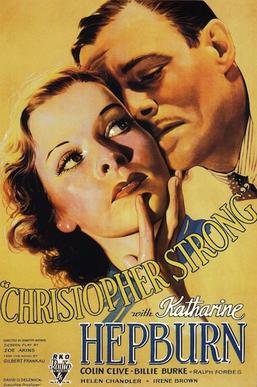
The motion picture was a "Woman's Story" and was directed by the only woman motion picture director at the time, Dorothy Arzner. She started directing with the additional footage shot for 1922's "Blood and Sand" starring Rosa Rosanova and Rudolph Valentino. Arzner finished directing her 20 feature films in 1943 with the World War Two "First Comes Courage" starring Merle Oberon and Brian Aherne.
The screenplay was by Zoe Akins from the novel by Gilbert Frankau. Poet, Playwright, Stage and Film Critic, Akins, wrote her first screenplay in 1925. She would write a total of 45 by 1959.
The Cast:
Katharine Hepburn portrayed "Lady Cynthia Darrington". Hepburn's next and third on-screen appearance was in 1933's "Morning Glory" based upon a play by Zoe Akins. Hepburn's performance in that picture would become her first Academy Award as "Best Actress".
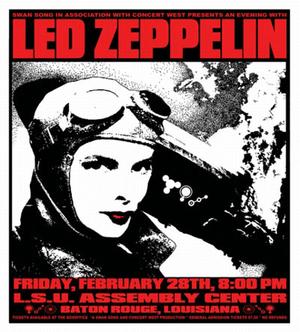
Above is a poster for Led Zepplin's 1975 American Tour. It is also a photo of Katharine Hepburn from this motion picture.
Colin Clive portrayed "Sir Christopher Strong".

Billie Burke portrayed "Lady Strong". Burke is probably best remembered as "Glinda, the Good Witch of the North" in 1939's "The Wizard of Oz". She also portrayed "Mrs. Clara Topper" in the popular "Topper" series that started in 1937. In that picture, Constance Bennett and Cary Grant are, the fun loving ghosts of "Marian and George Kirby" tormenting banker "Cosmo Topper" played by Roland Young.

Above, Katharine Hepburn, and Billie Burke.
Helen Chandler portrayed "Monica Strong". Chandler portrayed "Mina" in Todd Browning's 1931 "Dracula". Helen Chandler's last released motion picture was in 1938 and she returned to the legitimate stage. However, in 1940 her drinking problem, like Colin Clive's, got the best of her. She was committed to an asylum. In 1950 it is believed Chandler was smoking in bed and fell asleep. The resulting fire disfigured her.
Ralph Forbes portrayed "Harry Rawlinson". Forbes portrayed "John Geste" in the 1926 silent version of "Beau Geste" that starred Roland Colman He recreated the role in the 1931 sound version entitled "Beau Ideal". Forbes was fifth billed in 1927's "Mr. Wu" starring Lon Chaney, Sr. and in 1936 was in the Norma Shearer and Leslie Howard version of William Shakespeare's "Romeo and Juliet".

Above Ralph Forbes and Helen Chandler.
The Plot:
The story opens with "Monica" and "Harry" at her "Aunt Carrie's", played by Irene Browne, scavenger hunt. When the hunt ends "Carrie" comes up with a new challenge. Women must find a man married over 5 years, but still faithful. While the men must find a women over 20 who has not had an affair. Although "Monica" is 21, she and her boyfriend "Harry", do not meet the challenge's requirements.
"Monica" goes to see her father "Christopher Strong", who is a member of Parliament, and has been faithful to his wife for over 5 years. While on a motorbike "Harry" has a crash and "Lady Cynthia Darrington" sees it and helps him. "Harry" speaks to the aviatrix and learns that "Lady Darrinton" is over 20 years old.
This will lead to an affair between the pilot, "Lady Darrington", and the member of Parliament, "Sir Christopher Strong", as the story revolves around the two and the complications for each. All set off by "Monica Strong" and "Harry Rawlinson" wanting to win "Aunt Carrie's" challenge.


Three more dramatic films, 1933 "Looking Forward", 1934's "The Key" and "One More River" and then came the first sound version of authoress Charlotte Bronte's---
JANE EYRE released August 15, 1934

The feature would only run 62 minutes and was made by, the Poverty Row Studio, "Monogram Pictures". The assigned director was Christy Cabanne who directed 166 motion pictures between 1912 and 1948. Most of them were low "B's", but besides this picture. There was the Bret Harte Western, 1937's, "The Outcasts of Poker Flats" starring Preston Foster and 1940's, "The Mummy's Hand", introducing the Mummy "Kharis" portrayed by Tom Tyler.
The screenplay was by Adele Comandini. Who between 1926 and 1951 wrote, or co-wrote only 31 screenplays. The majority are forgotten low "B" features.
Virginia Bruce portrayed "Jane Eyre". Bruce was a "B" actress and is probably best known for the 1940 comedy "The Invisible Woman", from Universal Pictures, co-starring John Barrymore.

Above Colin Clive and Virginia Bruce
The movie is basically interesting because of who was in it. Rather than the story which severely cut a 296 page novel to fit one hour of screen time including the credits.
Below, look at this poster of the stars of the 1934 feature "The Firebird" and you will not see Colin Clive's name.

Clive was cast as "John Pointer", but he was let go after filming had begun and replaced by Lionel Atwill. The reason was his alcoholism, because Clive kept reporting to work, if he was even on time, drunk and slurring his lines.
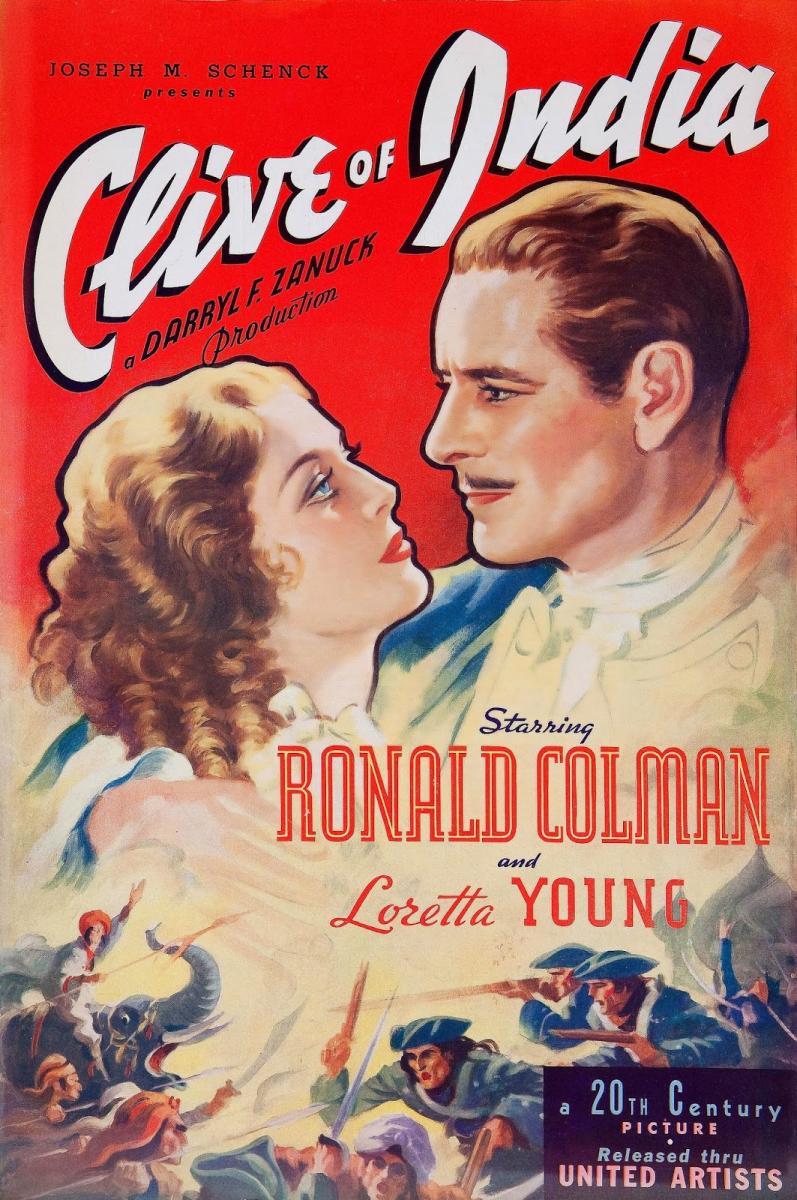
Another forgotten drama, 1935's "The Right to Live", and then it was back to "Henry Frankenstein".
BRIDE OF FRANKENSTEIN released April 19, 1935
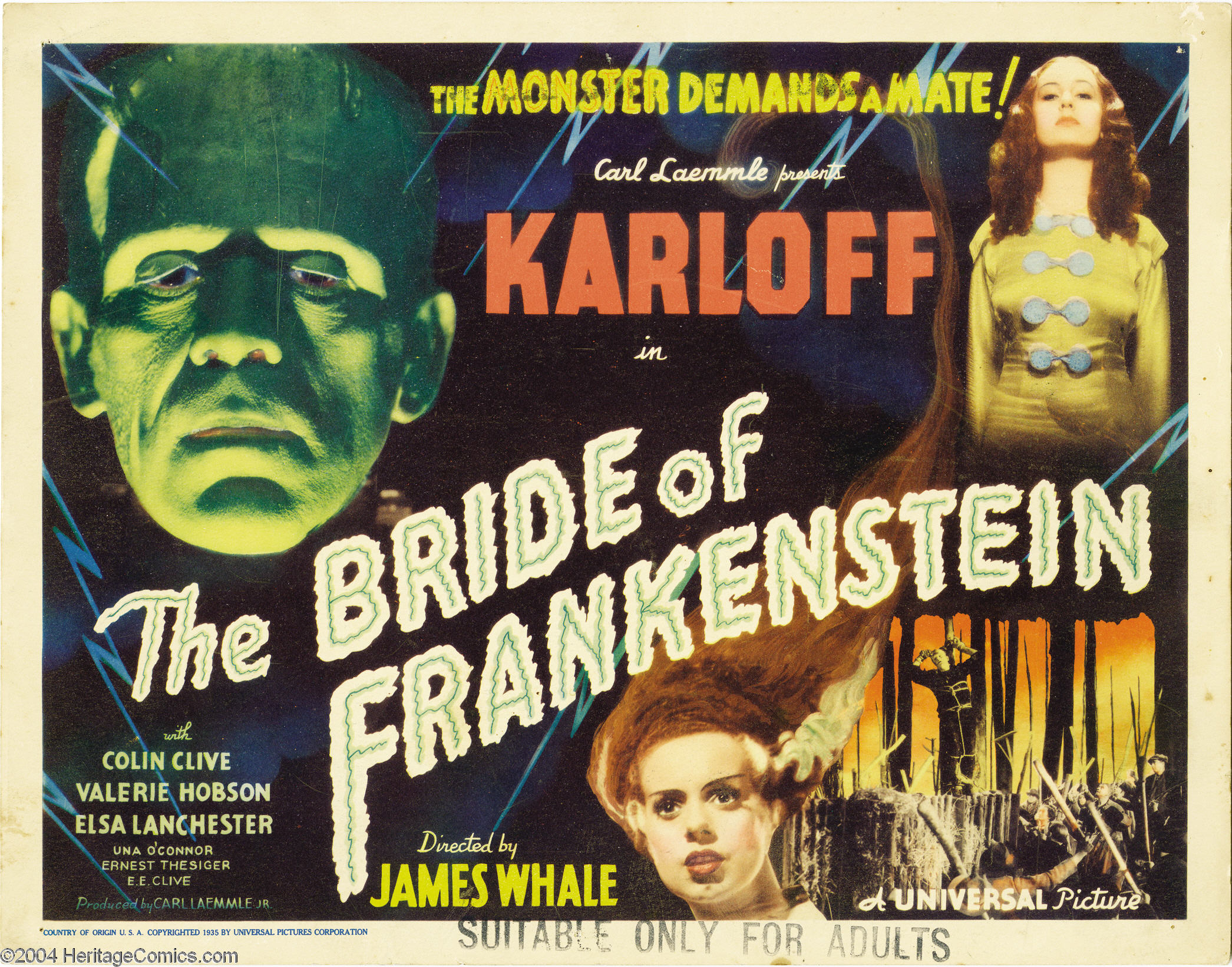
The above poster has the great tag line:
The MONSTER DEMANDS A MATE!James Whale was back to direct the picture and at least two of the original 1931 cast members returned in their roles, IF not in different billing positions.
With the success of the 1931 feature. Carl Laemmale, Jr. immediately went to work on a sequel, but creating a story and screenplay ran into problems. This was the cause of the four year delay between the first "Frankenstein" and the "Bride of Frankenstein".
Robert Forley wrote the first rejected screenplay, in 1932, entitled "The New Adventures of Frankenstein--The Monster Lives". The second rejected screenplay was by Tom Reed entitled "The Return of Frankenstein". In 1933 Reed's screenplay was passed by the "Hays Censorship Office", but James Whale, now assigned to direct, had the following opinion of Reed's work:
it stinks to heavenIn 1934 James Whale put John L. Balderston back to work on an adaption of Mary Shelley's novel this time, but with continuity to the original film. However, Reed's title remained as the working one. Then, after several months, Whale was not completely satisfied with Balderson and assigned a rewrite to William Hurlburt.
Hurlburt would be the only on-screen credited writer. He had been doing screenplays since 1915. In 1930 William Hurlburt adapted the Broadway "Horror-Mystery" "The Cat Creeps" into a successful motion picture starring actress Helen Twelvetrees. He wrote the screenplay for the Fannie Hurst novel "Imitation of Life", in 1934, starring Claudette Corbert and Warren William.
There were six more "Contributing Screenplay Writers" for the picture. They are Josef Berne, Lawrence G. Blochman, Philip MacDonald, R.C. Sheriff, Edmond Pearson and Morton Covan, before the final screenplay was accepted.
The Returning Original Members:
Boris Karloff was back as "The Monster" and also the star of the picture. Since the 1931 "Frankenstein" audiences had seen the actor in the previously mentioned 1932 "Scarface", director James Whale's 1932 "The Old Dark House", 1932's "The Mask of Fu Manchu" and "The Mummy". In 1933 Karloff was "The Ghoul" and in 1934 his films included the previously mention John Ford's "The Lost Patrol", "The House of Rothchild" and "The Black Cat" with Bela Lugosi and David Manners.
For the record Boris Karloff would be the monster one more time for Universal Pictures in 1939's "Son of Frankenstein". In 1958 he had the opportunity to portray "Dr. Frankenstein" in the very good "Frankenstein 1970".
_NRFPT_03.jpg)
Colin Clive was back as "Henry Frankenstein", but in second position now. Clive's performance is very much subdued. As compared to other actors who would have the role such as Peter Cushing and Kenneth Branagh. The reason was Clive had been thrown from a horse and broke his leg. Which limited his movement and the reason he is seen sitting, or laying down a lot. In some scenes other actors are actually holding up a drunken Clive.
Valerie Hobson now portrayed "Elizabeth". The Universal Studios contract player had appeared in 13 previous features. The most notable was the Charles Dickens 1935 "The Mystery of Edwin Drood" starring Claude Rains with Hobson at sixth billing.Valerie Hobson followed "Bride of Frankenstein" by portraying Henry Hull's wife in the first sound werewolf motion picture "The Werewolf of London". In 1946 Hobson co-starred with John Mills in director David Lean's still classic adaption of Charles Dickens' "Great Expectations". Trivia: In the 1934 production of "Great Expectations", starring Henry Hull, Valerie Hobson's scenes were all deleted from the final film.

Above Valerie Hobson and a lying down from the leg injury Colin Clive.
Ernest Thesiger portrayed "Doctor Septimus Pretorius". He'd been acting since 1916 and appeared in both Universal Studios 1933 "The Old Dark House" and "The Ghoul".

Above Colin Clive and Ernest Thesiger.
Elsa Lanchester portrayed the dual roles of "Mary Wollstonecraft Shelley" and the small role of the "Bride of Frankenstein". She was very familiar with Colin Clive's drinking problems.

Above "The Bride" makes herself more beautiful.
Two Supporting Actors:
Dwight Frye portrayed "Karl Glutz". "Glutz" was one of the henchman for "Dr. Petorious". It is a small part. For what the actor was doing between 'Fritz" and "Glutz", Please read by article on him.

Above Colin Clive, Dwight Frye and Ernest Thesiger.
John Carradine portrayed "A Lost Hunter at the Hermit's House". The Shakespearean actor was portraying very minor roles and you might have missed him.
The film opens on a stormy night when "Mary Shelley", "Percy Bysshe Shelley", Douglas Walton, and "Lord Byron", Gavin Gordon, were supposed to have been telling ghost stories and she came up with "The Modern Prometheus".
The comment is made about how terrifying the original story from the 1931 film had been and flashbacks are used, but Mary now adds there was more to her story and----
Villagers are gathered around the remains of the windmill in which the monster was killed. They mention poor "Henry Frankenstein" who has died and have his body taken to his home. There his fiancee "Elizabeth" sees him move and realize "He's Alive!".
Back at the windmill, "Hans", Reginald Barlow now playing the father of the drowned little girl played by John Ford's older brother Francis Ford in 1931's "Frankenstein", wanting to see the monster's bones leans too far over and falls into the remains of the windmill. There the still alive monster kills him and thinking its her husband. "Han's wife", Mary Gordon, helps the monster out and the creature now kills her.
The monster next encounters "Minnie", Una O'Connor, who flees in terror.
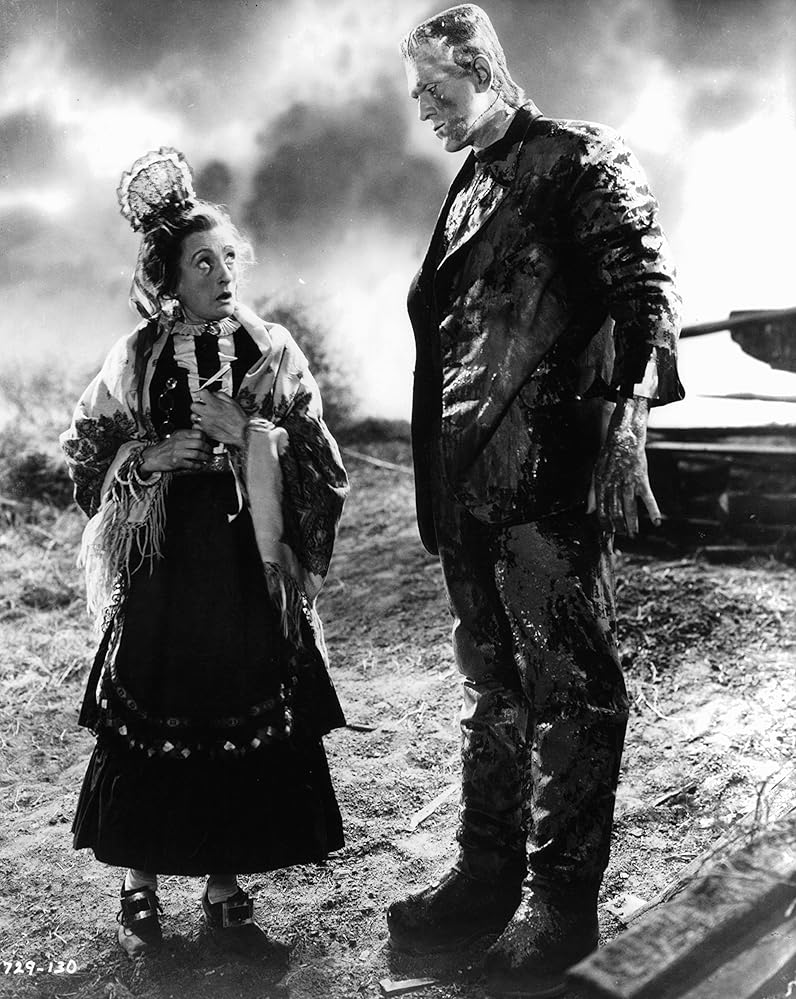
Above Una O'Connor and Boris Karloff
"Minnie" arrives at the "House of Frankenstein" and sounds the alarm that the monster is still alive, but nobody is listening to her as all attention is on "Henry",

Above Colin Clive, on his back, with Valerie Hobson and Una O'Connor.
"Henry" is nursed back to health and nobody seems to have remembered the monster.

Again the scene was set so that Colin Clive did not have to be on his legs.
"Henry" still thinks about the creation of life and now enters "Doctor Pretorius" with his own experiments in creating life.

"Pretorius" gets "Henry" to think about creating a female, a mate if you will, for the monster. With this agreement "Pretorius" exclaims in a toast:
To a new world of gods and monsters
"Gods and Monsters" became the motion picture title for a biographical feature on James Whale. The screenplay was based upon the book "Father of Frankenstein" by Christopher Bram.
Their agreement has "Pretorius" growing an artificial brain and "Henry" getting the "Spare Parts" for the body.
While this happening that monster saves the life of a young shepherdess, but seeing her rescuer she screams in fright. Two hunters come along and shoot at the monster. Pursued the monster is captured and placed in a dungeon.
The monster breaks its chains and escapes. The creature hears violin music and "Henry Frankenstein's" creation meets the blind hermit, O.P. Heggie, who teaches it to speak. However, two lost hunters discover the monster and not realizing he is now the hermit's "Friend", which he speaks to them, they attack and drive the creature away.
"Henry" decides not to go through with his agreement with "Dr. Pretorius". However, the monster and "Pretorius" meet in a crypt and a pack between them is made to force "Henry" to create its mate.
"Henry" and "Elizabeth" are married, but "Pretorious" appears to get him to complete their grand experiment. "Henry" refuses and "Pretorius" leaves and gets the monster to kidnap "Elizabeth".
Confirmed that she is unharmed, "Henry Frankenstein" agrees to create a mate for the monster and returns to the original tower laboratory and the work begins.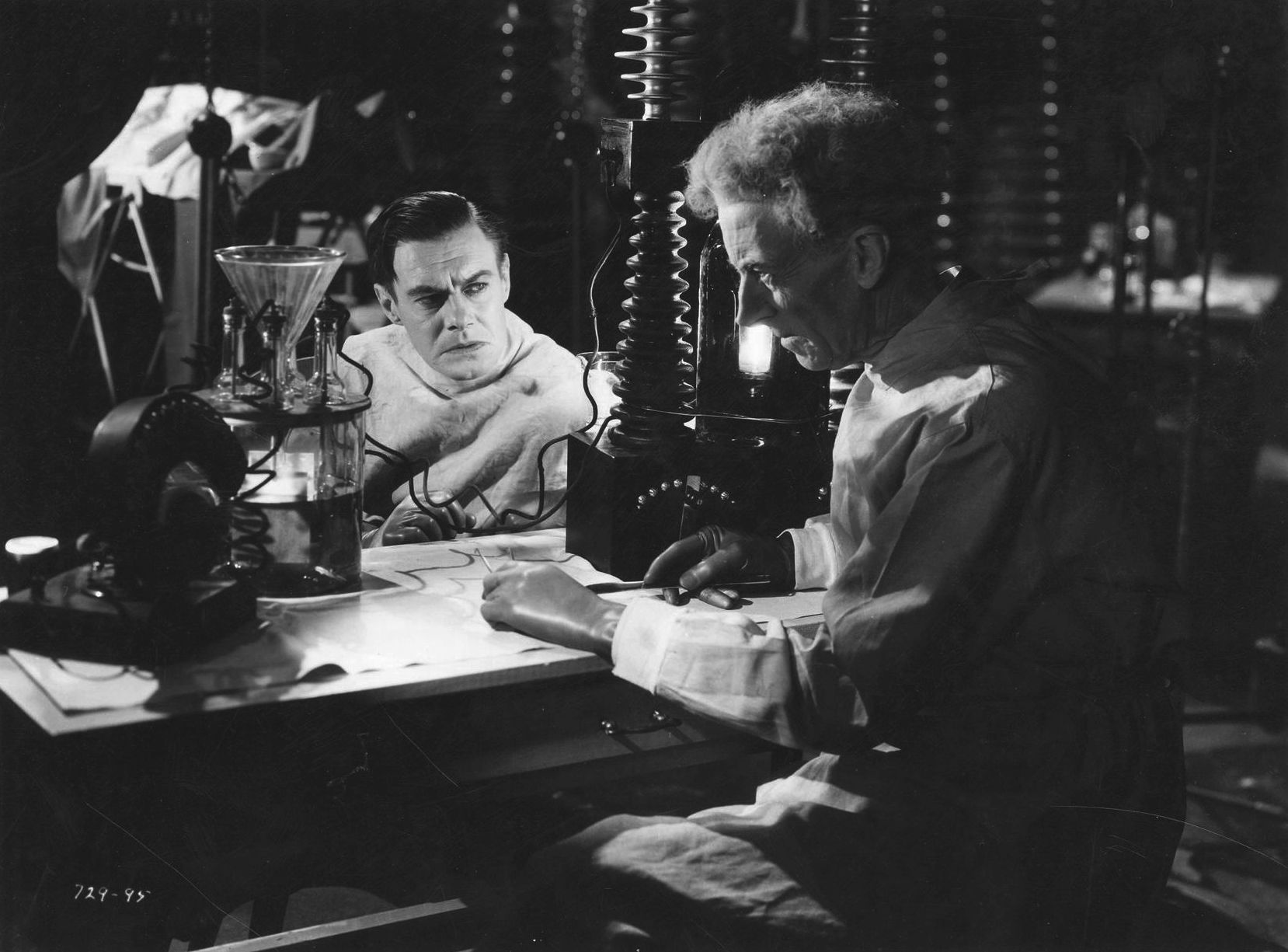
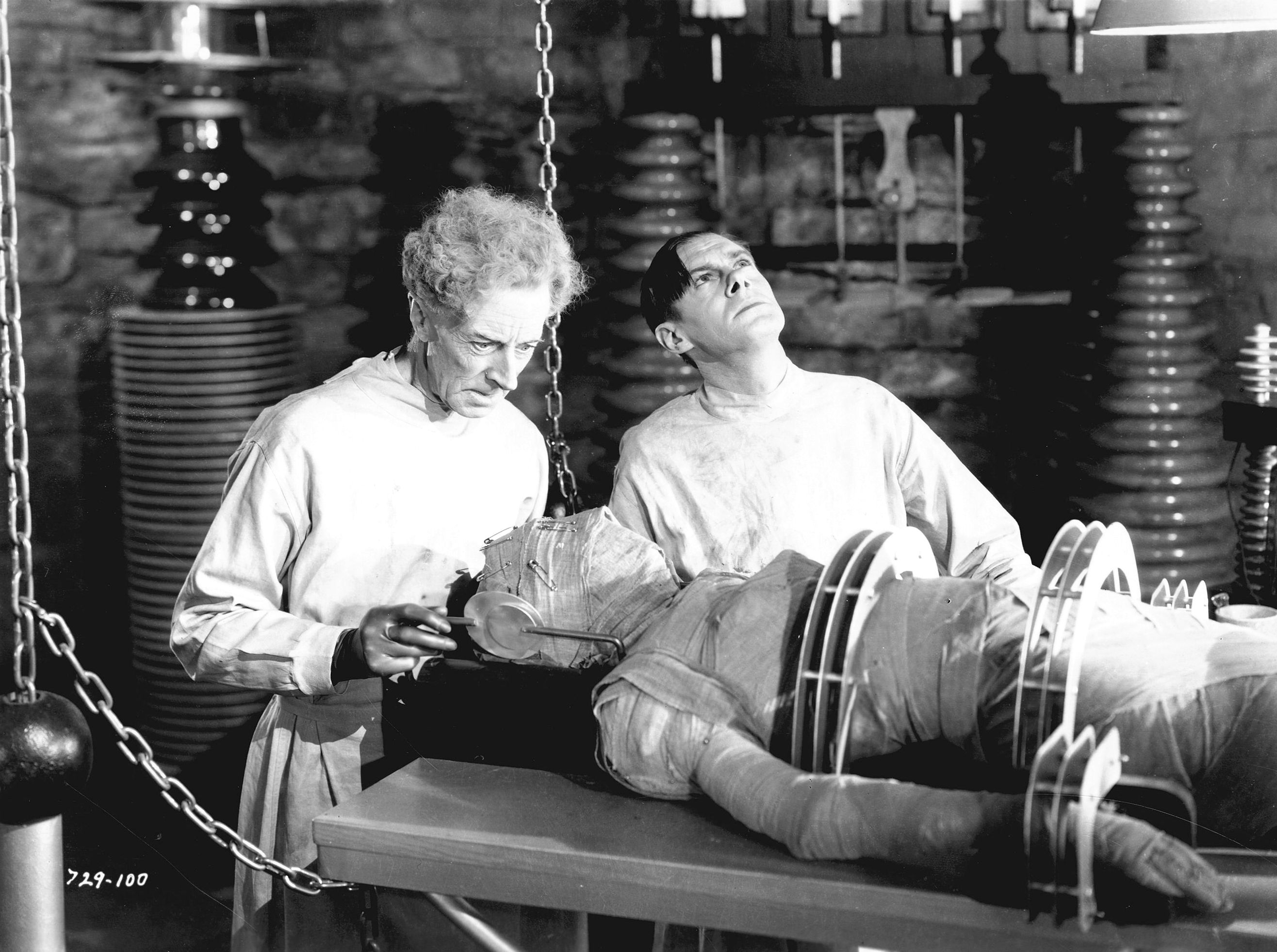


The "Bride" is actually frightened of her intended husband. Realizing the situation and showing its humanity. The monster lets "Henry" and "Elizabeth" go and then destroys himself, the bride and "Dr. Pretorius" by blowing up the tower laboratory.
"The Girl from 10th Avenue" followed on June 1st and starred Bette Davis, Ian Hunter. Colin Clive had third billing, but, again, I could not locate a photo of him.
Then came an overlooked Horror-Romance entitled:
MAD LOVE released July 12, 1935
The motion picture was directed by Austrian director Karl Freund. Who, like his star, Peter Lorre, escaped Germany as Hitler rose to power. Freund was actually a cinematographer and between 1911 and 1960 would have 161 film credits in that field including Fritz Lang's 1927 "Metropolis", Todd Browing's 1931 "Dracula" and John Huston's 1948 "Key Largo". His directing credits only number 20, but include 1932's "The Mummy".
The screenplay was based upon French author Maurice Renard's "Les Mains D'Orlac (The Hands of Orlac)". Florence Crewe-Jones translated the novel from the French.
Guy Endore adapted the novel and created the basic story line. Endore wrote the screenplays for Todd Browning's 1935 "Mark of the Vampire" and 1936's "The Devil Doll". He wrote the definitive werewolf novel, "The Werewolf of Paris". After being "Black Listed', because he was a Communist in the early 1950's. Endore wrote the screenplay for 1960's "The Curse of the Werewolf" based upon his novel. His life is extremely interesting and my article "Guy Endore: Black Listing and Communism In the Motion Picture Industry" may be read at:
http://www.bewaretheblog.com/2015/12/guy-endore-communism-in-motion-picture.html
John L. Balderson was one of the two screenplay writers. The other was P.J. Wolfson, a "B" writer of several genres and forgotten movies. Additionally, four other writers contributed without credit to the screenplay, Leon Gordon, Edgar Allan Woolf, Gladys Von Ettinghausen and Leon Wolfson.
The Cast:
Peter Lorre was the over the top "Doctor Gogol". This was the second English language feature for the star of Fritz Lang's 1931 crime classic "M". My article PETER LORRE: Overlooked, or Forgotten Performances" can be read at:
http://www.bewaretheblog.com/2017/11/peter-lorre-overlooked-or-forgotten.html
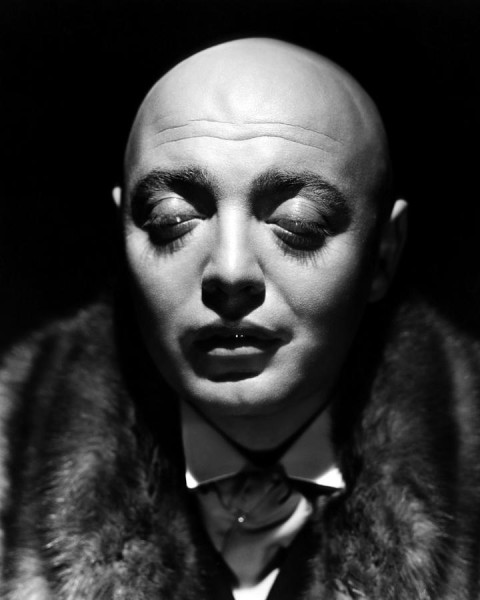
Frances Drake portrayed "Yvonne Orlac". Drake appeared in several "A" productions, but only had 24 film roles to his credit. She was fourth billed in 1934's "Bolero". Which starred George Raft showing off his dancing rather than gangster skills. In the classic 1935 "Les Miserables", the actress had fifth billing and in the "B" Horror entry from 1936 "The Invisible Ray". Francis Drake was billed third behind Boris Karloff and Bela Lugosi.
Colin Clive portrayed "Stephen Orlac". This was an excellent role for Colin Clive, but is always overshadowed by "Henry Frankenstein".
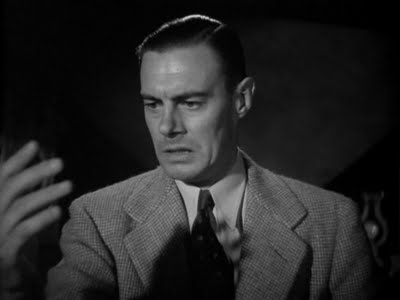
The Plot:
"Dr. Gogol" is a genius surgeon that is decades ahead of others, but has one weakness. He is obsessively in love with the stage actress "Yvonne Orlac". Who in turn loves her famous concert pianist husband "Stephen Orlac".
"Gogol" has attended every performance "Yvonne" has given at the "Theatre des Horreurs". That in this film is patterned after the real "Le Theatre du Grand-Guignol" in Paris, France. From its opening in 1897 until its closing in 1962 gave performances specializing in "Natural Horror Shows".
Tonight, is her last performance she awaits the radio performance of her husband "Stephen". 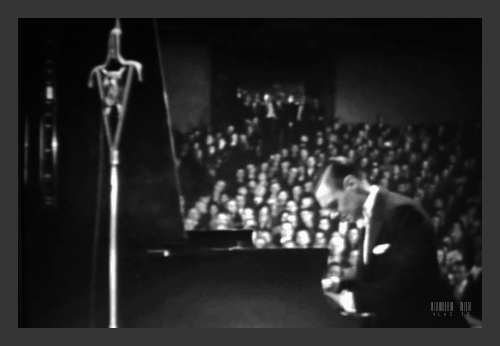
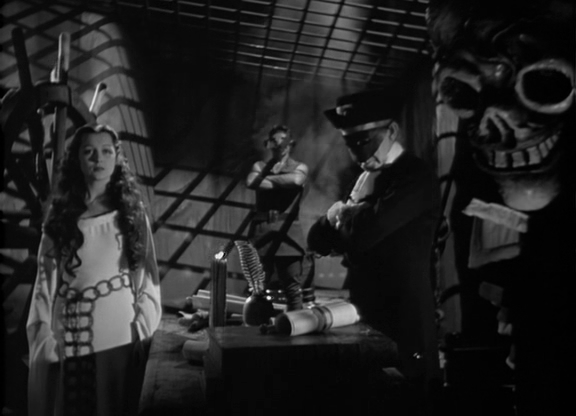
Above that last performance and below "Yvonne's" farewell party attended by "Dr. Gogol".
"Gogol's" love for "Yvonne Orlac" is so mad that he purchases the wax statue used in her performances and places it within his home inside his own bedroom.
Above a publicity photo of Frances Drake beside the wax statue.
Later as "Stephen" is riding the train from Fontainebleau to Paris to meet his wife. "Dr. Gogol" witnesses the execution of "Rollo the Knife-Thrower", Edward Brophy. Cut back to the train that crashes and roll down a mountain side."Yvonne" finds out that "Stephen's" hands have been crushed apparently ending his concert career.
She goes to "Dr. Gogol" for help and he agrees to perform surgery. 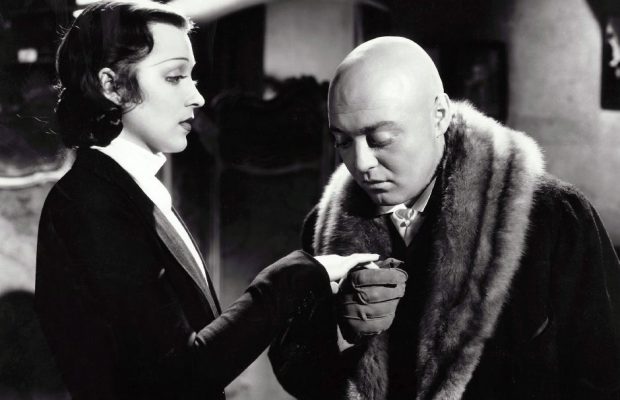

"Gogol" removes "Orlac's" damage hands and replaces them with those of "Rollo" without telling anyone. Yes, that's Keye Luke as "Dr. Wong".
"Stephen" and "Yvonne" have to sell their possessions to pay for the surgery he has had. When a creditor arrives and wants his payment. As if by reflex, "Stephen" throws a fountain pen he was holding. It just misses the other man's head and in-beds itself into the door as if it were a throwing knife. What's happening?
"Stephen" next goes to see his father, who has always been upset with his son for not becoming a jeweler like himself. He refuses to help and "Stephen" automatically picks up a knife and throws it at his father. Again, it misses, but breaks the front window of the jewelry store and he runs out.
"Stephen" goes to "Dr. Gogol" and confronts him about his new hands that want to throw knives. "Gogol" tells him it must be related to a childhood trauma and that it will pass. 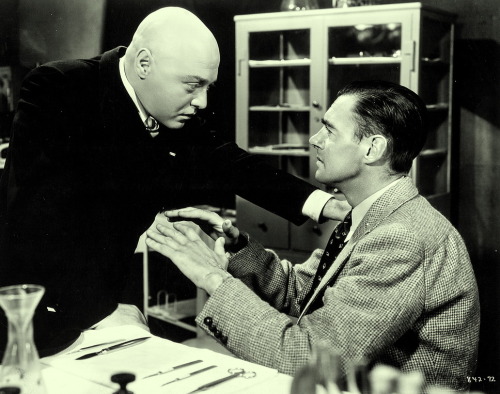
"Dr. Gogol" now suggests to "Yvonne Orlac" that she get away from "Stephen" as she may be in danger. She rejects "Gogol's suggestion while his own obsession with her grows.
Later "Stephen's" father is murdered and he receives a letter telling him to go to a certain address to learn the truth.
At the address he meets a man who claims to be "Rollo" brought back to life. The man has metallic hands and states his head was reattached to his body by "Dr. Gogol". According to "Rollo", "Stephen" has his real hands and murdered his father.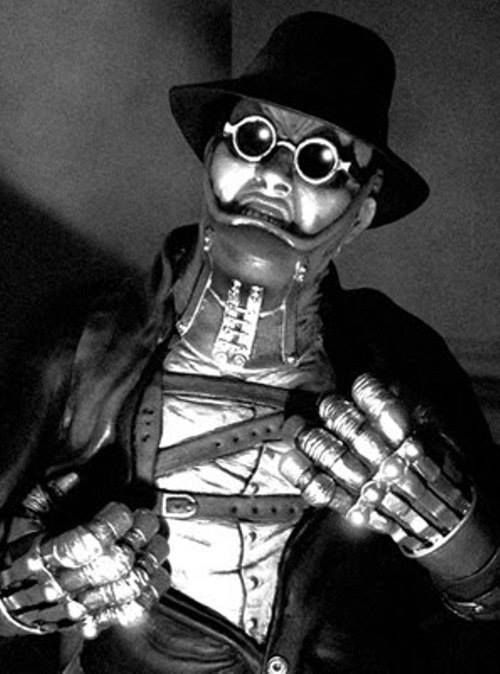

Of course this is "Dr. Golgo". "Stephen" leaves and goes back to his house and tells "Yvonne" what has transpired and that he must go to the police and turn himself in for the murder of his father. 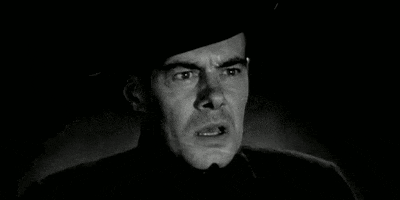
In panic "Yvonne Orlac" goes to "Dr. Gogol" for help. A reporter, named "Reagan", who met "Dr. Gogol" at "Rollo's" execution and found him acting strange. Already been to the "Gogol's" looking for a story. He is now watching it and sees her arrive.
After gaining admittance, "Yvonne Orlac" finds the statue of herself. As from the street "Reagan" watched the doctor return and enter. 
After "Yvonne" see "Gogol" take off his disguise and realizes he is completely made. He does not see the statue, but "Yvonne Orlac" an thinks she is his statue brought to life by the Greek Goddess "Galatea" of myth. "Gogol" now starts to strangle the real "Yvonne" for being rejected by her.
Seeing whats actually happening, "Reagan" goes for the police and finds "Stephen" there. He explains what he's saw and that it was "Gogol" that murdered "Stephen's" father. The three arrive, but can't get inside the room. Pulling out a knife, "Stephen" throws it with accuracy through a window killing the doctor and saving his wife.
Third billing in another Ronald Colman picture "The Man Who Broker the Bank at MonteCarlo", released November 15, 1935, immediately followed "Mad Love".
Then it was "The Widow from Monte Carlo" that premiered on December 19. 1935 with fourth billing ending the year 1935. Colin Clive had no films during 1936 and on April 15, 1937. Colin Clive's final film, "The Women I Love", starring Paul Muni, Miriam Hopkins and Louis Hayward opened.
Two months later on June 25, 1937 Colin Clive passed away from pneumonia brought on by alcoholism. As I said at this article opening he was just 37 years old.
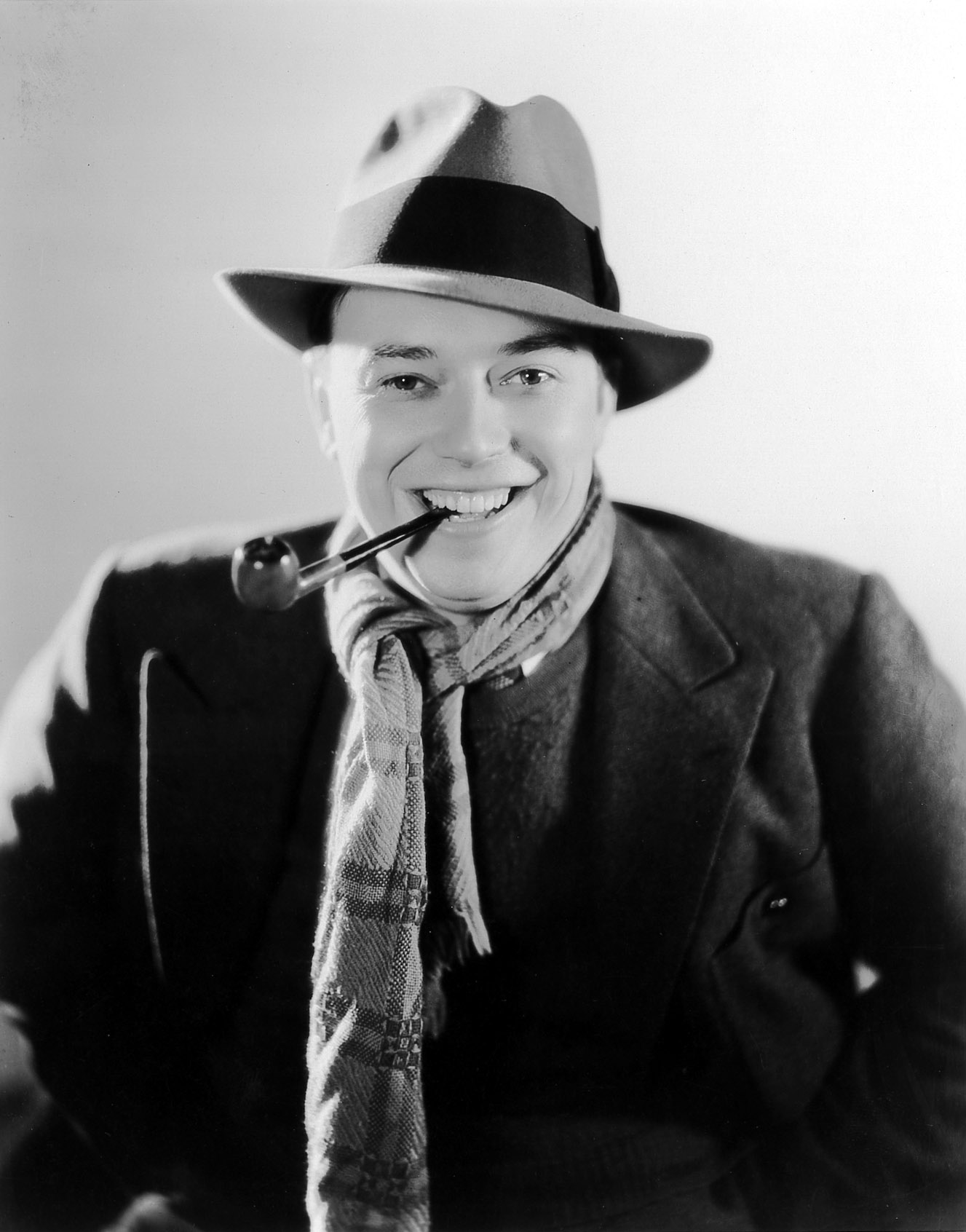











No comments:
Post a Comment